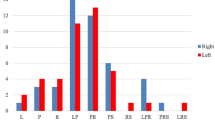Abstract
Purpose To evaluate the epidemiology and outcome of ocular trauma in southern Turkey. Methods Patients referred to the University of Çukurova, School of Medicine, Department of Ophthalmology, with ocular trauma during the last two years were reviewed retrospectively. Age and gender of patients, type of injury, cause of injury, place where injury occurred, initial and final visual acuities, and final outcome were analyzed. Results Medical records of 250 patients (four bilateral injuries), aged between three months and ninety years were reviewed. Ocular trauma mostly occurred between 0 and 15 years and a male preponderance (76.8%) was evident. There were 72% open-globe injuries, corneal and/or scleral penetration being the most common injury type. Metallic objects were the main cause of injury (32.4%). Fifty percent of injuries happened in streets. Closed-globe and self-sealing corneal injuries were found to have the best prognosis in terms of final outcome (57.6% and 57.9%, respectively; P < 0.001 for both). Initial visual acuity was found to be a significant predictor of final visual acuity (P < 0.001). Endophthalmitis was significantly associated with metallic objects (P < 0.005). Conclusion Eye injury is still a common and avoidable cause of blindness. Our findings suggest that any person in the population can be subject to ocular trauma at any time. Prognosis might be challenging. Education, attention, and safety precautions would help in reducing ocular morbidity.
Similar content being viewed by others
References
Strahlman E, Elman M, Daub E, Baker S (1990) Causes of pediatric eye injuries. A population based study. Arch Ophthalmol 108:603–606
Rapoport I, Romem M, Kinek M, Koval R, Teller J, Belkin M, Yelin N, Yanco L, Savir H (1990) Eye injuries in children in Israel. Arch Ophthalmol 108:376–379
De Respinis PA, Caputo AR, Fiore PM, Wagner RS (1989) A survey of severe eye injuries in children. Am J Dis Child 143:711–716
Nelson LB, Wilson TW, Jeffers JB (1989) Eye injuries in childhood: demography, etiology, and prevention. Pediatrics 84(3):438–441
Soliman MM, Macky TA (2008) Pattern of ocular trauma in Egypt. Graefes Arch Clin Exp Ophthalmol 246:205–212. doi:10.1007/s00417-007-0720-4
Dandona L, Dandona R, Srinivas M, John RK, McCarty CA, Rao GN (2000) Ocular trauma in an urban population in southern India: the Andhra Pradesh Eye Disease Study. Clin Experiment Ophthalmol 28:350–356. doi:10.1046/j.1442-9071.2000.00334.x
Vats S, Murthy GVS, Chandra M, Gupta SK, Vashist P, Gogoi M (2008) Epidemiological study of ocular trauma in an urban slum population in Delhi, India. Indian J Ophthalmol 56:313–316
Desai P, McEwen CJ, Baines P, Minassian DC (1996) Incidence of cases of ocular trauma admitted to hospital and incidence of blinding outcome. Br J Ophthalmol 80:592–596. doi:10.1136/bjo.80.7.592
Cillino S, Casuccio A, Di Pace F, Pillitteri F, Cillino G (2008) A five-year retrospective study of the epidemiological characteristics and visual outcomes of patients hospitalized for ocular trauma in a Mediterranean area. BMC Ophthalmol 8:6. doi:10.1186/1471-2415-8-6
Kuhn F, Morris R, Witherspoon CD, Heimann K, Jeffers JB, Treister G (1996) A standardized classification of ocular trauma. Ophthalmology 103:240–243
Rahman I, Maino A, Devadason D, Leatherbarrow B (2006) Open globe injuries: factors predictive of poor outcome. Eye 20(12):1336–1341. doi:10.1038/sj.eye.6702099
MacEwen CJ, Baines PS, Desai P (1999) Eye injuries in children: the current picture. Br J Ophthalmol 83:933–936. doi:10.1136/bjo.83.8.933
McCarty CA, Fu CL, Taylor HR (1999) Epidemiology of ocular trauma in Australia. Ophthalmology 106:1847–1852. doi:10.1016/S0161-6420(99)90361-5
Rofail M, Lee GA, O’Rourke P (2006) Prognostic indicators for open globe injury. Clin Experiment Ophthalmol 34(8):783–786. doi:10.1111/j.1442-9071.2006.01309.x
Soylu M, Demircan N, Yalaz M, Isiguzel I (1998) Etiology of pediatric perforating eye injuries in Southern Turkey. Ophthalmic Epidemiol 5(1):7–12. doi:10.1076/opep.5.1.7.1493
Kim JH, Yang SJ, Kim DS, Kim JG, Yoon YH (2007) Fourteen-year review of open globe injuries in an urban Korean population. J Trauma 62(3):746–749. doi:10.1097/01.ta.0000231557.58471.e3
Thompson CG, Kumar N, Billson FA, Martin F (2002) The aetiology of perforating ocular injuries in children. Br J Ophthalmol 86:920–922. doi:10.1136/bjo.86.8.920
Andreotti G, Lange JL, Brundage JF (2001) The nature, incidence and impact of eye injuries among US military personnel: implications for prevention. Arch Ophthalmol 119(11):1693–1697
Sternberg P Jr, Juan E Jr, Michels RG, Auer C (1984) Multivariate analysis of prognostic factors in penetrating ocular injuries. Am J Ophthalmol 98:467–472. doi:10.1016/0002-9394(84)90133-8
Smith D, Wrenn K, Stack LB (2002) The epidemiology and diagnosis of penetrating eye injuries. Acad Emerg Med 9(3):209–213. doi:10.1111/j.1553-2712.2002.tb00246.x
Filipe JAC, Fernandes VL, Barros H, Reis FF, Correia JC (2003) Soccer-related ocular injuries. Arch Ophthalmol 121:687–694. doi:10.1001/archopht.121.5.687
Essex RW, Yi Q, Charles PGP, Allen PJ (2004) Post-traumatic endophthalmitis. Ophthalmology 111(11):2015–2022. doi:10.1016/j.ophtha.2003.09.041
Author information
Authors and Affiliations
Corresponding author
Rights and permissions
About this article
Cite this article
Soylu, M., Sizmaz, S. & Cayli, S. Eye injury (ocular trauma) in southern Turkey: epidemiology, ocular survival, and visual outcome. Int Ophthalmol 30, 143–148 (2010). https://doi.org/10.1007/s10792-009-9300-4
Received:
Accepted:
Published:
Issue Date:
DOI: https://doi.org/10.1007/s10792-009-9300-4




